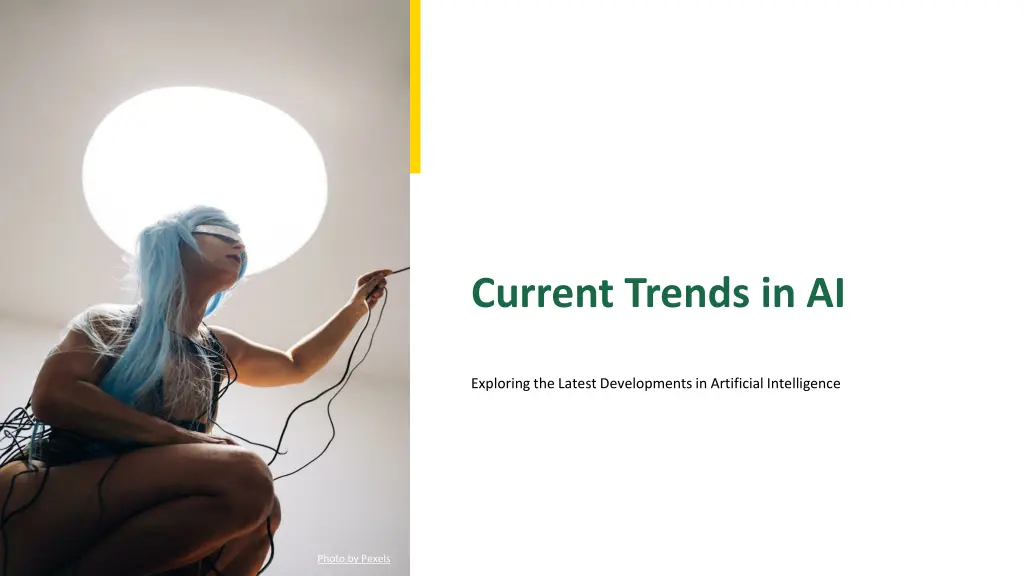
Exploring Latest Developments in Artificial Intelligence Trends
Dive into the latest trends in artificial intelligence, including deep learning techniques, natural language processing, computer vision, robotics, healthcare applications, and ethical considerations. Discover how AI is transforming industries, addressing ethical concerns, and shaping the future of technology.
Download Presentation

Please find below an Image/Link to download the presentation.
The content on the website is provided AS IS for your information and personal use only. It may not be sold, licensed, or shared on other websites without obtaining consent from the author. If you encounter any issues during the download, it is possible that the publisher has removed the file from their server.
You are allowed to download the files provided on this website for personal or commercial use, subject to the condition that they are used lawfully. All files are the property of their respective owners.
The content on the website is provided AS IS for your information and personal use only. It may not be sold, licensed, or shared on other websites without obtaining consent from the author.
E N D
Presentation Transcript
Current Trends in AI Exploring the Latest Developments in Artificial Intelligence Photo by Pexels
01 Introduction to AI Trends Table of Contents 02 Deep Learning Techniques 03 Natural Language Processing 04 Computer Vision 05 Robotics and Automation 06 AI in Healthcare 07 Ethical Concerns in AI 08 AI in Manufacturing 09 AI in Finance 10 AI in Retail 11 Future Potential of AI 12 Conclusion
1 Introduction to AI Trends Understanding the Evolution of AI Artificial Intelligence has rapidly evolved in recent years, impacting various industries. Recent advancements in machine learning techniques like deep learning and transfer learning. AI applications in natural language processing, computer vision, robotics, and healthcare. Addressing ethics concerns such as bias, privacy, job displacement, and security risks. Photo by Pexels
2 Deep Learning Techniques Innovations in Neural Networks Advancements in neural network architectures and training methods. Leveraging pre-trained models to improve learning in new tasks. Automated machine learning tools for model selection and hyperparametertuning. Deep learning's impact on industries like manufacturing, finance, and retail. Photo by Pexels
3 Natural Language Processing Revolutionizing Communication NLP enables machines to understand, interpret, and respond to human language. Revolutionizing customer service through chatbots and virtual assistants. NLP facilitates multilingual communication, breaking down language barriers. NLP helps extract valuable insights from vast amounts of data. Photo by Pexels
4 Computer Vision Seeing the World Through AI AI's ability to recognize and interpret images with high accuracy. Computer vision's role in the development of self-driving cars. Enhancing medical imaging and diagnostics through computer vision. Improving security systems with advanced image and video analysis. Photo by Pexels
5 Robotics and Automation AI in Action AI-driven automation in manufacturing and production processes. Robots assisting in customer service and hospitality industries. Robots aiding in surgeries and patientcare. Exploring the potential of robotics in various sectors. Photo by Pexels
6 AI in Healthcare Transforming Medical Practices AI's role in predicting patientoutcomes and disease trends. Tailoring treatments to individualpatients using AI insights. Enhancing diagnostic accuracy with AI-powered imaging tools. AI's contribution to remote healthcareservices. Photo by Pexels
7 Ethical Concerns in AI Navigating the Challenges Addressing the issue of bias in AI algorithms and data. Ensuring data privacy and protectionin AI applications. The impact of AI on employment and job markets. Mitigatingsecurity risks associated with AI technologies. Photo by Pexels
8 AI in Manufacturing Revolutionizing Production AI-driven automation and optimization in manufacturing processes. Enhancing product quality through AI-powered inspection systems. Optimizing supply chains with AI analytics and forecasting. AI's role in promoting sustainable manufacturing practices. Photo by Pexels
9 AI in Finance Transforming Financial Services AI's ability to detect and prevent fraudulent activities. Using AI algorithms for high-frequency trading and investment strategies. Enhancing customer interactions with AI-powered chatbots. AI's role in assessing and managing financial risks. Photo by Pexels
10 AI in Retail Enhancing Customer Experience AI's ability to offer personalized product recommendations. Optimizing inventory levels with AI analytics. Gaining insights into customer behavior throughAI analysis. Improving customer service with AI-driven virtual assistants. Photo by Pexels
11 Future Potential of AI Exploring New Horizons AI's potential to personalize learning experiences and improve education. Enhancing crop management and yield predictions with AI. Optimizing energy consumption and production with AI technologies. AI's role in advancing space exploration and research. Photo by Pexels
12 Conclusion The Impact of AI on Society AI's ability to transform industries and improve quality of life. The importance of balancing technological advancements with ethical considerations. The need to prepare for AI's continuedimpact on society. Encouraging the responsible and innovative use of AI technologies. Photo by Pexels
